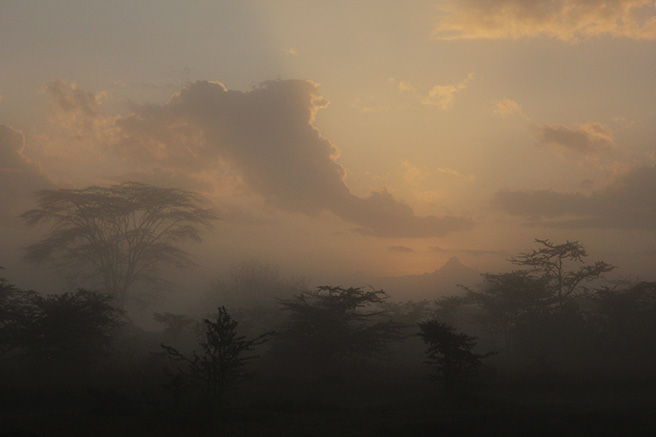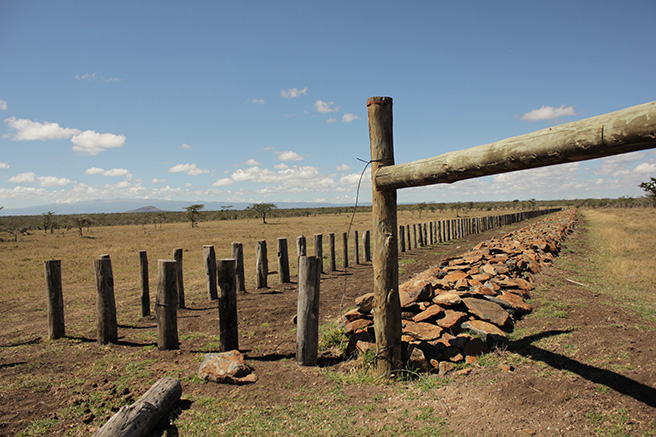The Wildlife and Wild Lands of Kenya

Is there anything more wonderful than travel? Few experiences provide more lasting memories, and even fewer modify your perceptions more distinctly. Traveling has a way of making the world seem bigger, and smaller, simultaneously.
I will never forget my first night on the Laikipia Plateau. We arrived at the Ol Pejeta Conservancy, in the AWF’s Samburu Priority Landscape—a roundly diverse group of eight students from George Mason University. The first leg of our trip was just getting started, and we were nothing if not excited—calling out to each other as we saw our first warthog, “Oo, look! A zebra!” “There are some hyenas!” “Gazelle!” “Aww, look at the impala!” (In hindsight, I marvel at the patience of our guides.) But we were there for more than safari.
Thanks to the work of our instructor, Ryan Valdez (who is currently conducting research in the region) we were being given the opportunity to participate in a unique study-abroad program focused on conservation and ecology, which offered access to personnel and facilities that would have otherwise remained closed. We had just enough time to tuck our things into our bandas (small circular houses with thick thatched roofs) at the research camp where we would be spending the next five days, before being whisked away at dusk. We drove quite a ways until we met a field of open grassland, the iconic silhouettes of A. xanthoploea, Yellow Fever trees, on the horizon. It was here we settled to observe our first sunset, a large herd of zebra grazing in the foreground, flanked by the Abedare Mountains.
In Laikipia, the nights are cool and the skies are very dramatic. That first night the sky was faintly purple, with lightening flickering in the distance. Dark clouds billowed at the tips of the blue colored-mountains, haloed in a warm pink light. Crepuscular rays stretched to the earth. As the world became darker, we headed back to camp in what would become our usual fashion –standing on the seats, exposed to the world through the open roof, the wind licking at our skin. To me, the sky had never felt so vast, and I had never felt more present.
I breathed in the cool night air, tinged with the scent of smoke, and stared at the stars above. It had been a long time since I’d been someplace so expansive, and though the sense of space I experienced there would later be dwarfed by confronting the Masai Mara, it was my first glimpse of the Kenya I had dreamed of, and of a thing I wanted to exist: Wilderness.
Then a thick cluster of lights caught my eye. It was a village far off in the distance. Innocent as it was the sight of it saddened me, as it reminded me that we were not alone, and made my wilderness seem smaller. I wondered if there is anywhere we have not touched? But this thought was followed by a far more troubling one: does wilderness still exist, and if so, for how long?
----------------------
As stunning as my adventure would be—the amazing wildlife, the incredible landscapes, speaking with conservationists and our wonderful guides (who were as funny and kind as they were knowledgeable)—I found myself troubled.
Perhaps it started in Nairobi, as we passed Kibera—the second-largest slum in all of Africa (to call it a “shanty-town” would be painting it brightly). Or maybe it was the visit to the dilapidated primary school at Soysambu Conservancy. How can the needs of these people, the sheer volumes of people, be met while conserving wildlife? Can a balance be found, and is there really any hope we will find it?
It’s not that I am naive; I had worried over these things before. I knew about the encroachment of humans on the world’s wild places, but I had wanted to believe that somewhere there were places that, if not immune, at the very least had more time. Yet, one swollen town after another broke this optimistic lie.
In the face of such bleak thoughts, it is comforting to know that the AWF possesses so many forward thinkers. The foundation fully understands that without building up Africa’s people, conserved wild lands will not be retained. For development to occur sustainably, with minimum impact to wildlife, humans must be doing well and not struggling, and they must be empowered to become involved in conservation, as well as benefit from its results.

Back in Nairobi, our group had the opportunity to speak with Dr. Philip Muruthi at the AWF headquarters. Over tea, he discussed the breadth of challenges AWF faces, and I gained a greater appreciation for the scale and diversity of the foundation’s current programs. A recurring theme was the need to conserve land outside protected areas. Kenya’s national parks currently exist as islands amidst an increasingly fragmented landscape due to human beings. These beautiful places are unfortunately not large enough to sustain the scale of wildlife populations that exist within them. Currently more animals exist outside parks than within, which leads to increased conflict with humans as the animals inevitably move into the small farms, or large-scale agricultural establishments. There is no question these animals are destructive, so it is of no great surprise that many landowners view them as pests threatening their means of subsistence.
Conservation partners can help guide the direction of development by influencing zoning and incentivize landowners to dedicate some or all of their land to wild populations. In this way, even modest sections of land can come to some use as corridors into larger stretches of habitat. Meanwhile, the landowners are more tolerant of the presence of wild animals because they experience the benefits of participating.
On our last day at Ol Pejeta, the group drove out to the northern-most end of the conservancy to view one of its three wildlife corridors, in the late stages of construction. It was a rather simple design. By driving pylons into the ground at a set distance from each other, and to a specific height, the planks act as a barrier for the endangered black rhino population (which are heavily protected within the confines of the conservancy) while animals such as elephants and antelope can easily step over or through them. These corridors are limited to the northern end of the conservancy as a means of discouraging movement to more developed areas where risk of human conflict is greater.
Incorporating non-protected lands and wildlife corridors into conservation strategies is not just important for sustaining available habitat, it also allows for animals to perform their ecological roles within our communities. Human beings are just as reliant on a healthily functioning ecosystem as any other animal, and the presence of wildlife is crucial to maintaining ecosystem services in ways that scientists are only beginning to fully understand.
_________________________
I once read that civilization created wilderness—for nomadic hunters and gatherers, who represented our species for most of its existence, there was no such word. “Everything natural was simply habitat, and people understood themselves as part of a seamless living community” (Roderick Frazier Nash, Wilderness and the American Mind). If we were to resist our idealized notion of wilderness as something to be framed and put on display, would we come to see it as a necessary aspect of our world? As much a part of us as any other creature? Would we live by its rules, instead of our own? Whatever the answer to these questions, we must find a way for wildlife to exist within our world, not just outside it. While wildlife corridors are not an easy-fix to the problems of fragmentation, they help to mitigate the effects of an existing predicament.
As for the thoughts that troubled me? It’s fine to be realistic in assessing the magnitude of challenges faced by conservationists, but what’s important is to remain inspired by the amazing individuals who continue to invest in the struggle. Because of them, I am still full of hope.
This is a guest blog from George Mason University's Kenya Ecology and Conservation course with instructor Ryan Valdez. The students stayed at the research centre of the Ol Pejeta Conservancy while in Africa and visited AWF's headquarters to learn about conservation and share their experiences.